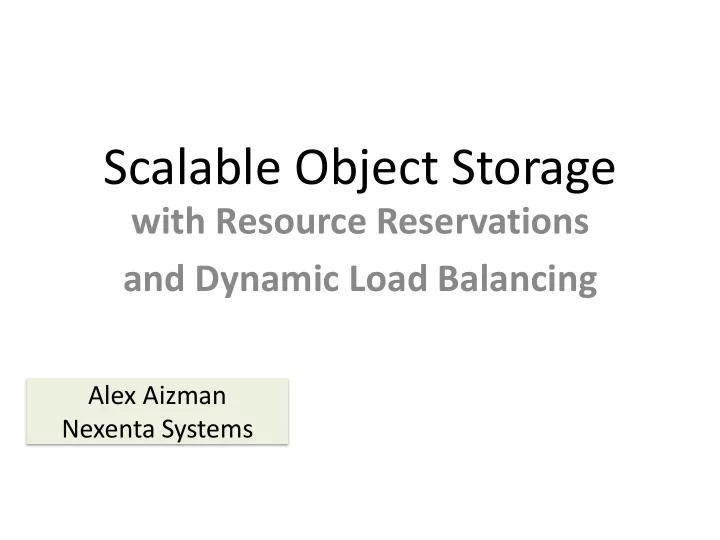

Scalable Object Storage with Resource Reservations and Dynamic Load Balancing Alex Aizman Nexenta Systems
The Setup • Within Data Center • Scale: 100+ nodes to unlimited • Optimized for latency; no spikes at high utilization – No “fat tails” • Layer 1 of storage stack is object – Storing and transporting immutable crypto-checksummed KVT
More Requirements • Copy-on-write, eventually consistent – Put creates a new version • Multiple replicas – Multiple replicas on the wire? • “Rampant Layering Violation” • No Incast – Mostly known as TCP Incast • No/Minimized Convergence – Multiple link- sharing flows “converge” to fair share • Linearly scalable and load balanced at all times – Uniform distribution != balanced distribution
The Claim Edge-driven resource allocation New Storage Protocol Required
Distributed clusters Unstructured Distributed Clustered Namespace Federated (striped/sharded) • GPFS Location tracking DLM • Lustre C MDS • pNFS (*) • GFS, HDFS Consistent • Ceph • Maglev • Swift Hash P A (Scale-Out + ? Load Balancing)
Minimizing flow latency Deadline-aware Deadline-agnostic Schemes Schemes Flow Switch Scheduling Support Replicast ™ DCTCP D 3 D 2 TCP PDQ DAQ (*) Schemes for Fast Transmission of Flows in Data Center Networks (**) Analysis of DCTCP: Stability, Convergence, and Fairness
Congestion: give control to the target! • Reserved bandwidth 100% utilized - Impact of one connection terminating? - Zero (or minimal) competition between flows • Compare with SJF/EDF/PDQ..
Motivations: Transport L5 over TCP Replicast Performance Throughput + fare-share Completion time General purpose Yes No Multiple replicas on the wire Yes No Mature and stable L4 Yes No (TCP) Incast Yes No Congestion control (L2) + L4 L2 + Replicast Retry L4 Replicast DCB traffic class Depending on the app Yes Motivations: Storage Replicast Built-in deduplication Yes Consistent hashing + Yes Inline load balancing Target Resource reservation Yes (Network, Disk) (Yes, Yes)
Replicast: edge-based load balancer
Tradeoffs – Protocol Variations • There is always a cost and associated tradeoffs • Replicast: all designated targets must share the timeslot • Variations(*): 1) Multicast control plane + unicast delivery 2) Choosy Initiator 3) The Better Protocol - and more (*) https://storagetarget.com
Protocol Simulation • Replicast is designed for 1000s of nodes • SURGE framework @https://github.com/hqr/surge • Each node is a goroutine; fully owns its configured resources • Any-to-any connect via Go channels • Time modeling • Same-size payload chunks indexed by a cryptohash of their content • And consistently hashed to: a) groups (Replicast), b) targets (unicast) • Non-blocking no-drop network core that connects all 10GbE ports • Flow isolation: protected VLAN • Transmission errors are sufficiently rare and therefore not modeled • Reads are modeled but remain out of scope (and space)
The “fair comparison” dilemma • Unicast Consistent Hash, Captive Congestion Point – Consistent hashing for target selection – Unicast UDP for both control and data – Idealized bandwidth reservations: RATE INIT and RATE SET – Immediate start (as opposed to TCP slow start) – 3x lower connection-setup overhead vs. Replicast
put throughput: 90x90, 128K Results 176,000 180,000 160,000 127,900 140,000 108,900 replicast-m 120,000 chunks/s 80,700 100,000 uch-ccp 73,400 58,400 80,000 replicast-h 60,000 40,000 20,000 0 400 1,000
Replicast: reservation conflicts Poisson 𝝁 Chunk Put interarrival time probability 16K 11us 0.09 46.7% 128K 50us 0.02 13% 1MB 500us 0.002 1.39% 16K chunks
Next Steps • Optimizations for small chunks • Optimizations for concurrent gets and puts • Optimal ratios of initiators to targets • Optimal sizing of the load-balancing groups • Load balancing proxies • Kernel bypass (DPDK) • Bit Index Explicit Replication (BIER) – Stateless multi-point replication
Instead of conclusions: Guiding Principles • Location independence: both chunks and MD • No SPOF (no single-MDS, at least on this level) • Inline load balancing | Inline global dedup • Storage-level end-to-end resource reservation • 100% bandwidth utilization – During the reserved timeslot • Single copy on the wire – If possible • Close-to-open, ACID/transactional and other types of consistency – by upper layers • and more
Credits: Caitlin Bestler Thank You
Recommend
More recommend